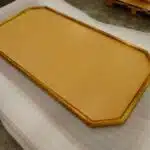Caulking a window is an important task that, when done correctly, can help to improve the energy efficiency and overall appearance of your home. This simple process involves filling gaps and cracks around your windows with a waterproof sealant to prevent drafts and water damage. If you’re looking for a cost-effective way to increase the comfort and security of your home, learning how to caulk a window could be just what you need.
In this article, we’ll provide step-by-step instructions on how to properly caulk a window. Whether you’re a seasoned DIY enthusiast or new to home improvement projects, our guide will walk you through everything you need to know about selecting the right materials, preparing the area for caulking, and applying the sealant in order to achieve lasting results. So if you’re ready to take control of your home’s energy efficiency and curb appeal, read on for our expert tips on how to caulk a window like a pro.
Assessing Your Windows For Caulking Needs
As homeowners, we all strive to make our homes as energy-efficient and comfortable as possible. One way to achieve this is by properly caulking windows to prevent air leaks. Assessing window frames for caulk needs is the first step in ensuring that your home is well-sealed against drafts, moisture, and pests.
Start by examining the window frames both inside and outside of your home. Look for gaps or cracks between the frame and the wall; these can be a sign of air leaks. Additionally, check the caulking around the glass panes of your windows. If you notice any gaps or cracks in this area, it’s time for new caulking. Identifying air leaks early on will save you money in heating and cooling costs down the line.
Another factor to consider when assessing your windows for caulk needs is their age. Older windows are more likely to require new caulking due to wear and tear over time. If your windows are more than ten years old or show signs of damage such as rotting wood or cracked glass, it’s important to address these issues before proceeding with caulking.
Now that you’ve assessed your windows for caulk needs, it’s time to choose the right caulk for your project. By taking into account factors such as indoor/outdoor use, material compatibility, and ease of application, you’ll be able to select the best product for sealing your windows effectively.
Choosing The Right Caulk For Your Window
When it comes to caulking your windows, choosing the right type of caulk is essential. There are different types of caulk available in the market, and each has its own set of advantages and disadvantages. It’s important to consider certain factors such as durability, weather resistance, and flexibility before selecting a caulk for your windows.
Types of Caulk:
- Silicone Caulk: Provides excellent waterproofing and is ideal for areas that are exposed to water.
- Acrylic Latex Caulk: Good for interior use but not recommended for outdoor projects.
- Polyurethane Caulk: Offers a strong bond and is suitable for both indoor and outdoor applications.
- Butyl Rubber Caulk: Great for sealing tight spaces and joints, but not very flexible.
Durability:
When selecting a caulk for your window, you want to choose something that will last. The durability of the caulk depends on several factors such as exposure to sunlight, extreme temperatures, and moisture. If you live in an area with harsh climate conditions, it’s recommended to go with silicone or polyurethane caulks as they offer better protection against these elements.
Flexibility:
Another important factor to consider when selecting a caulk is its flexibility. Windows expand and contract due to temperature changes throughout the year, so you need a caulk that can move with them without cracking or breaking down over time. Polyurethane caulks are known for their flexibility and are a great option if you have older windows that may shift slightly throughout the year.
Now that we’ve covered the types of caulk available and what factors to consider when selecting one, it’s time to gather all the necessary tools and materials needed for caulking your windows properly.
Gathering The Necessary Tools And Materials
Gathering the necessary tools and materials is the first step in any home improvement project, and learning how to caulk a window is no exception. To begin, the tools necessary for the job include a caulking gun, utility knife, putty knife, and a damp cloth. As for materials, the most important item to have is a quality sealant or caulk. Additionally, a sealant remover can be helpful for projects that require the removal of old caulk. Preparing the area for caulking is also essential, which includes cleaning the window and surrounding area with a mild soap. Finally, having a drop cloth on hand to protect the floor from potential spills is a must.
Gathering Tools
Before starting the task of caulking a window, it is important to gather all the necessary tools and materials to ensure that the job is done right. Choosing the right tools for the job can make all the difference in achieving a professional-looking finish. When selecting tools, consider the size of the window and the type of caulk you will be using.
Setting up your tools for success is also crucial when preparing to caulk a window. Start by placing all of your chosen tools in a convenient location near your work area. This will save time and prevent unnecessary trips back and forth to grab forgotten items. You may also want to lay down some protective covering on your work surface, such as drop cloths or old towels, to help keep things clean while you work.
Some essential tools for caulking a window include a caulk gun, caulk smoothing tool, utility knife, and possibly a ladder if needed. Once you have gathered these items and set up your workspace, you are ready to begin the process of caulking your window. With these steps in mind, you can achieve a flawless finish that will keep out drafts and moisture while improving energy efficiency in your home.
Identifying Materials
Now that you have gathered all the necessary tools for caulking a window, it’s time to move onto identifying the right materials. Choosing the right caulk is just as important as having the right tools, and can greatly impact the success of your project. When selecting caulk, there are several different types to consider.
The first step in choosing caulk is to determine what type of material your window frame is made from. For example, if your frame is made of wood, you will want to use a caulk specifically designed for wood surfaces. This will ensure that the caulk adheres properly and provides a long-lasting seal. Other factors to consider when choosing caulk include its flexibility, durability, and resistance to weathering.
Different types of caulk also have different application methods. Some come in tubes and require a caulk gun for application, while others come in squeeze bottles or tubs that can be applied with a putty knife or other tool. It’s important to read the manufacturer’s instructions carefully to ensure that you choose the right type of caulk and application method for your specific project.
By taking the time to identify and select the right materials for caulking your window, you can achieve a professional-looking finish that will help improve energy efficiency in your home while keeping out drafts and moisture. With these tips in mind, you’ll be well on your way to completing this essential home improvement task with confidence.
Preparation
Before you start caulking your window, make sure to conduct a thorough window inspection. It is important to assess the condition of your windows and determine any potential issues that may need to be addressed before sealing. Check for cracks, gaps, or rotting wood that could hinder the effectiveness of the caulk. If there are any signs of damage or decay, it’s best to replace these areas before proceeding with caulking.
Once you have inspected your windows and identified any necessary repairs, it’s time to prepare the surfaces for sealing. Start by cleaning the area thoroughly using a mild detergent and warm water. Remove any dirt, dust, or debris from the surface using a clean cloth or brush. Allow the area to dry completely before moving on to the next step.
After cleaning and drying the window frame, you can use masking tape to protect adjacent surfaces such as walls or frames from excess caulk. This will prevent unwanted smears or drips during application. You can also use a primer if needed to ensure maximum adhesion between the caulk and surface material. By following these preparation steps, you can ensure that your caulking project will be successful in keeping out drafts and moisture while improving energy efficiency in your home.
Preparing The Area For Caulking
Just like a chef who prepares and gathers all the necessary ingredients before cooking, window preparation is an essential step in caulking. Before you begin applying new caulk, it’s crucial to inspect the area around your window frame thoroughly. Look for any cracks or gaps that may need filling. Once you identify these areas, gather all the tools and materials you’ll need for this task.
Window preparation involves removing any old caulk and cleaning the surface of the window frame thoroughly. Old caulk can be challenging to remove, so it’s best to use a putty knife or a caulk removal tool. Be sure to wear protective gloves and eye goggles when removing old caulk as it can be sharp and potentially hazardous. Once you’ve removed all the old caulk, clean the surface of your window frame with soap and water or rubbing alcohol.
Surface cleaning is a vital step in preparing your window for new caulk application. Any dirt or debris left on the surface can interfere with proper adhesion between the new caulk and the window frame, leading to poor results. Use a clean cloth or sponge to wipe down the area around your window frame after washing it with soap and water or rubbing alcohol. Your goal is to ensure that there are no traces of dirt or debris on the surface before applying new caulk.
To move forward with removing old caulk and cleaning the surface effectively, start by using a putty knife or a caulk removal tool. Once you’ve removed all traces of old caulk, use soap and water or rubbing alcohol to clean your window frame thoroughly. Remember that proper cleaning will ensure successful adhesion of new caulking material onto your windowsill. So take your time during this process and avoid rushing through it; otherwise, you may have to redo everything from scratch again!
Removing Old Caulk And Cleaning The Surface
Before applying new caulk, it is crucial to remove the old one. Removing caulk can be a challenging task, but it is necessary for a clean finish. To begin removing old caulk, you will need some tools such as a utility knife, a putty knife or scraper, or a caulk removal tool. The right tools for removing old caulk depend on the type of material you are working on.
Once you have removed the old caulk, it’s time to clean the surface thoroughly. Proper surface cleaning techniques are essential to ensure that the new caulk adheres correctly. Choosing the right cleaning solution is vital; some surfaces require specific cleaners to avoid damage. Before cleaning, ensure that there is no debris left on the surface by gently wiping it with a damp cloth.
After cleaning and drying the surface completely, prepare it for new caulking by roughening up its texture with sandpaper or steel wool. This step helps improve adhesion and ensures that the new sealant sticks to the surface adequately. In addition, inspect the area carefully to identify any gaps or cracks that need filling in before applying new caulk.
- Use gloves and protective eyewear when removing old caulking.
- Avoid using sharp tools when removing old caulking near glass surfaces.
- For difficult-to-reach areas such as corners, use an angled scraper.
- For stubborn residue left behind after removing old caulking, use rubbing alcohol.
In preparation for applying a backer rod for larger gaps, follow these steps carefully to remove all traces of old caulk and ensure your surfaces are clean and ready for sealing.
Applying A Backer Rod For Larger Gaps
When it comes to caulking windows, larger gaps require a different approach. This is where backer rods come in handy. A backer rod is a cylindrical foam material that is used to fill gaps between two surfaces before applying caulk. It helps to prevent the caulk from sinking into the gap and ensures that it adheres properly to both surfaces.
One of the benefits of using a backer rod is that it can save you time and money in the long run. Without a backer rod, you may need to apply multiple layers of caulk to fill a large gap properly. This can take longer and require more materials, which means more time and money spent on the project. Additionally, using a backer rod helps to create a more professional-looking finish by ensuring that the caulk is evenly distributed throughout the gap.
While backer rods are an excellent choice for larger gaps, there are alternatives available for smaller ones. For instance, if you have small gaps, you can use painter’s tape as an alternative to backer rods. Simply place the tape along both sides of the gap before applying caulk to prevent it from spreading out too much. However, keep in mind that while this method can save time and money upfront, it may not provide as long-lasting results as using a backer rod.
In summary, when caulking windows with larger gaps, incorporating a backer rod into your process can be beneficial in terms of efficiency and professionalism. For smaller gaps, alternatives such as painter’s tape may work but may not provide lasting results like those achieved with backer rods. In our next section, we’ll talk about cutting the caulk tip to the right size for optimal results without wasting any materials or time.
Cutting The Caulk Tip To The Right Size
After applying the backer rod, it’s time to move on to choosing the right caulk tip. Using the correct size will ensure that the caulk is applied evenly and smoothly. In fact, according to a recent study by Home Improvement Magazine, using the wrong size caulk tip is one of the top reasons for uneven caulking.
To choose the right caulk tip, start by looking at the size of your gap. If it’s relatively small, a 1/8 inch tip will work well. For larger gaps, use a 1/4 inch or even 3/8 inch tip. It’s also important to note that some caulking guns come with adjustable tips that can be modified to fit any gap size. Once you’ve selected your tip, it’s time to load up your caulking gun and get started on smoothing out your caulk.
Using a caulk smoothing tool is essential for achieving a professional-looking finish. After applying the caulk, run the tool along the bead in one smooth motion to eliminate any bumps or ridges. This will create a clean line that not only looks great but also helps seal out drafts and water leaks. Now that you’ve chosen your tip and smoothing tool, let’s move on to loading up your caulking gun for application.
Loading The Caulk Into The Caulking Gun
Proper loading techniques for a caulking gun are essential to ensure that caulk is dispensed evenly and consistently, resulting in a professional-looking finish. Before loading the gun, it is important to select the type of caulk that best suits your needs. Silicone and latex-based caulks are two of the most common types available on the market.
To start loading the gun, first remove the plunger from the back of the gun. Then, cut off the tip of the caulk tube at a 45-degree angle with a sharp utility knife. Make sure to cut just enough so that you can easily insert it into the caulking gun without any excess material getting in your way.
Common mistakes when loading a caulking gun include not removing enough of the tube’s tip, causing too much pressure on the plunger. Another mistake is not securing the tube properly in place, which can cause it to fall out while applying caulk. By following correct loading techniques, you can avoid these errors and achieve a smooth application every time.
As we have discussed proper techniques for loading your caulking gun with caulk, it is now time to begin applying it to your window frame or sill. Using small sections at a time will allow you greater control over where you apply your bead of caulk and prevent any wasted product. Always remember to work slowly and carefully as rushing can lead to mistakes and unsightly results.
Beginning To Caulk The Window
To begin caulking the window, you must first assess the gaps between the window frame and the wall. This step is crucial as it will help you determine how much caulk you need to use. To assess the gaps, run your finger along the edges of the window frame to feel for any gaps or cracks. You can also use a flashlight to visually inspect for any light shining through. Once you have identified these areas, measure their length and width, so you know how much caulk to apply.
The next step is identifying the materials needed for caulking. You will require a caulking gun and a tube of caulk suitable for window frames. It’s essential to ensure that you purchase a high-quality caulk that is designed specifically for windows as it will provide excellent adhesion and flexibility once it dries. Additionally, make sure that your caulking gun fits comfortably in your hand as this will allow you to apply steady pressure when using it.
Incorporating these steps into your caulking process will ensure that your window is adequately sealed against drafts and water leaks. Now that you have assessed the gaps and identified the necessary materials let’s move on to applying steady pressure on the caulking gun, which is key to creating an even seal around your window frame.
Applying Steady Pressure On The Caulking Gun
To apply caulk to a window properly, it is essential to use the right technique. Applying consistent pressure on the caulking gun is critical for ensuring that the caulk is evenly distributed along the gap between the window frame and wall. However, this process requires patience as well as practice to avoid air bubbles and other common issues.
Before applying caulk, it is essential to choose the right type of caulk based on your window’s material. For instance, silicone-based caulk works well with vinyl or aluminum windows, while acrylic-based caulk might be more appropriate for wooden frames. Once you have chosen the right type of caulk, make sure you are using a good quality caulking gun that allows you to control the flow of the material.
To apply consistent pressure on the caulking gun evenly, hold it at a 45-degree angle and slowly squeeze the trigger with one hand while guiding it with another. Practice proper technique by starting at one end of the window and work your way towards the opposite end in a continuous motion. Troubleshoot common issues such as air bubbles by puncturing them with a pin or toothpick before smoothing out any excess material.
Now that you have applied consistent pressure to ensure even distribution of caulk along your window frame’s gap, smooth out any excess material using a caulking smoothing tool. This tool ensures that your caulk has an even finish and helps in achieving a professional look.
Smoothing The Caulk With A Caulk Smoothing Tool
After applying the caulk, it’s important to smooth it out with a caulking smoothing tool. This will ensure that the caulk fills all the gaps and cracks around the window evenly. There are different types of caulking tools available in the market, including those made of plastic, metal or rubber.
When choosing a caulking tool, consider the type of caulk you are using. For instance, if you are working with silicone caulk, choose a tool made of plastic as metal can damage the surface. Additionally, some people prefer to use alternative tools such as a popsicle stick or their fingers instead of a dedicated caulking tool. While these may work for small projects, it’s best to have a dedicated tool for larger jobs.
Remember that smoothing out the caulk is an important step in ensuring that your window remains well-insulated and energy-efficient. Take your time when going over each section of the window frame to ensure that there are no gaps or air leaks. Once you have finished smoothing out the caulk, move onto cleaning up any excess caulk before it dries and hardens on your windowsill.
Cleaning Up Excess Caulk
As you finish caulking your windows, you may have noticed excess caulk that needs to be cleaned up. Don’t worry, cleaning up the excess is an easy process that can be done with just a few simple cleaning techniques.
Firstly, wait for the caulk to dry before attempting to clean it up. Trying to remove wet caulk will only smear it around and create a bigger mess. Once the caulk has dried, use a plastic scraper or putty knife to gently scrape away any excess that is sticking out. Be careful not to scrape away too much or damage the surrounding area.
Next, use rubbing alcohol or white vinegar on a cloth or paper towel to remove any residue left behind by the caulk. These substances are great at breaking down and dissolving any leftover caulk without damaging the surface underneath. Be sure to clean thoroughly until all of the residue has been removed.
Now that you’ve successfully cleaned up the excess caulk and residue, it’s time to allow the remaining caulk to dry and cure properly. This step is crucial in ensuring that your window remains properly sealed and protected from outside elements. In the next section, we will discuss how long you should wait for your caulk to dry before moving forward with any additional steps in your home improvement project.
Allowing The Caulk To Dry And Cure
After cleaning up excess caulk, it’s time to let the caulk dry and cure. This is an important step in ensuring that the caulking does its job effectively. One of the most common mistakes people make at this stage is not allowing enough time for the caulk to dry. It’s important to follow the manufacturer’s instructions on how long it takes for the specific type of caulk you’re using to dry and cure.
Tip: Make sure the area where you applied caulking is free from moisture or humidity. High levels of humidity can prolong drying times, which can result in a weaker seal. Additionally, avoid touching or disturbing the caulk while it dries as this can lead to uneven drying and cause issues with adhesion.
Once you’ve waited for the recommended amount of time for your specific caulk type, it’s important to check for any missed areas. Carefully inspect all sections of your window or door frame that were previously caulked, and ensure there are no gaps or missed spots. If there are any missed areas, apply additional caulking as necessary and repeat the process until everything is sealed correctly. Checking for any missed areas is essential in guaranteeing a proper seal around your windows and doors, which will help prevent drafts and reduce energy costs in your home.
Checking For Any Missed Areas
When caulking a window, it is important to inspect the window to determine the areas that need to be caulked. A wide putty knife can be used to trace along the window frame to determine any missed areas. After tracing along the window frame, inspect the knife for any caulk residue which can indicate areas that may have been missed. If any caulk residue is found, it is necessary to apply additional caulk to those areas.
Inspecting The Window
When it comes to caulking a window, inspecting the window is an essential step before beginning the process. Inspecting the window helps identify any common issues that may need fixing before caulking. Ensure that the window frame is in good condition and free from any cracks or gaps.
Common issues with windows include gaps or cracks in the frame, missing glazing putty, and loose or missing hardware. These issues can cause air leaks, which lead to energy loss and higher utility bills. Checking for these issues before caulking ensures that they are addressed, preventing them from worsening over time.
In conclusion, inspecting the window is a crucial step before caulking. It helps identify common issues such as gaps or cracks in the frame, missing glazing putty, and loose or missing hardware. By addressing these issues before caulking, you can prevent them from causing further problems down the line.
Using A Knife To Trace The Caulk
After inspecting the window and caulking it, it’s essential to check for any missed areas. Even if you are thorough during the caulking process, there may still be gaps or holes that you missed. These can cause air leaks, which lead to energy loss and higher utility bills. Checking for missed areas ensures that your windows are well-sealed and energy-efficient.
One technique for checking for missed areas is using a knife to trace the caulk. This tip involves running a sharp knife along the length of the caulk line to ensure that there are no gaps or holes in the sealant. If you come across any missed areas, fill them with new caulk until they are properly sealed. By using this technique, you can be sure that your windows are well-sealed and energy-efficient.
Another tip for using a knife to trace the caulk is to use a utility knife with a fresh blade for best results. A dull blade may not cut through the caulk cleanly, making it difficult to identify any missed areas. Additionally, ensure that you apply consistent pressure as you trace along the caulk line. This will help you identify any gaps or holes in the sealant more easily. Using these techniques can help ensure that your windows are properly sealed and energy-efficient.
Enjoying The Benefits Of A Properly Caulked Window
As the saying goes: “A stitch in time saves nine.” This is especially true when it comes to caulking your windows. Not only does proper caulking save you money by reducing energy bills, but it also protects your home from water damage and reduces noise pollution.
One of the primary benefits of caulking is improved energy efficiency. When your windows are properly sealed, they prevent air leaks which can cause drafts and increase heating and cooling costs. According to the U.S Department of Energy, homeowners can save up to 20% on heating and cooling costs by sealing air leaks and adding insulation. Properly caulked windows also reduce outside noise, making your home a quieter place to relax.
In addition to saving money on energy bills, caulking provides protection against water damage. Water intrusion through poorly sealed windows can lead to rotting wood frames, mold growth, and even structural damage. By sealing gaps around your window frames with caulk, you can prevent water from seeping in and damaging your home. It’s essential to inspect your windows periodically for any signs of wear or tear in the caulk and replace it as needed to ensure maximum protection for your home.
By taking the time to properly caulk your windows, you’ll reap the benefits of improved energy efficiency while also protecting your home from potential damage caused by air leaks and water intrusion. So don’t wait until it’s too late – invest in caulking today!
Conclusion
Caulking your windows is a quick and easy home improvement project that can help reduce energy costs and increase the comfort of your living space. It is important to assess your windows for caulking needs, choose the right caulk, gather the necessary tools and materials, and prepare the area before beginning. Removing old caulk and cleaning the surface are essential steps in ensuring a proper seal. Excess caulk should be cleaned up promptly to avoid any unsightly mess.
While some may argue that caulking windows is a tedious task, it is a small price to pay for the benefits that come with a properly sealed window. Anticipated objections such as lack of time or difficulty in completing the project can easily be overcome by breaking it down into manageable steps or seeking out professional assistance. By taking action to properly seal your windows with caulk, you will not only save money on energy costs but also contribute to reducing environmental impact. With just a little bit of effort, you can enjoy the benefits of a more comfortable and efficient home.
Image Credits
- “Window” by Rameshng (featured)





























